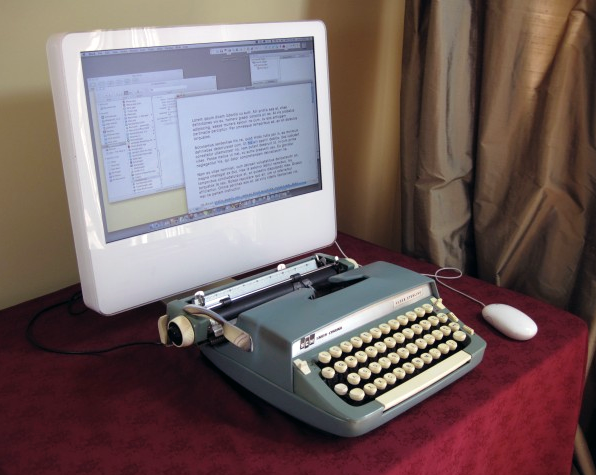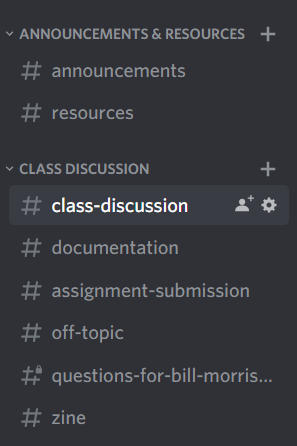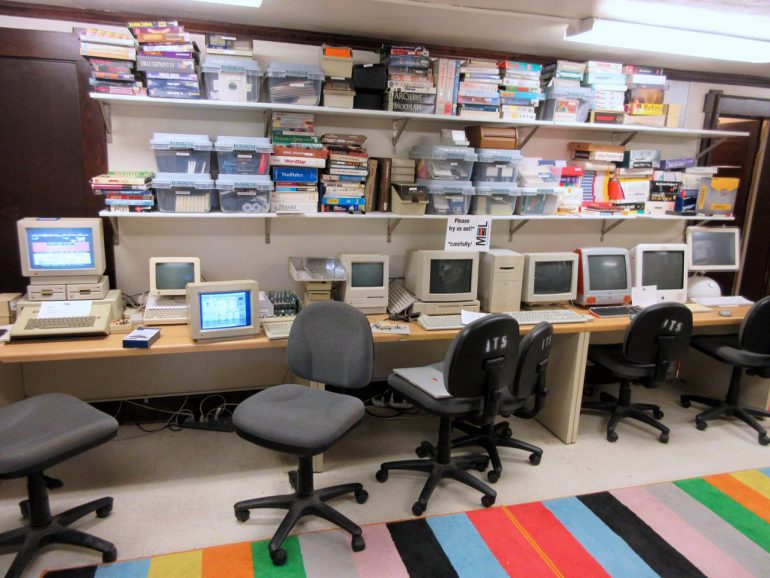This past term I was a teaching assistant for the senior undergraduate course Counter-Archives and Residual Media Production in Concordia University’s Communication department. Structured as a studio practicum, the course emphasized the conception, design, and execution of media works, with class time heavily favouring production exercises.
The “residual media” aspect of the course was inspired by definitions posed by Raymond Williams and Charles Acland, that focus on the ongoing uses and situations of allegedly outmoded technologies such as typewriters, vinyl records, and cassette players. Defining “counter-archives” is a bit more of a slippery exercise, but in the context of the course they were broadly conceived of as repositories that evade or subvert traditional structures of access and organization.
As a teaching assistant, my main responsibility was running Friday morning media production labs. However, in early-term planning sessions with my professor, we quickly recognized two challenges facing us. First, residual media doesn’t necessarily do online well. Running an in-person course would have allowed us to distribute materials directly to students — say, by bringing in a box of old film reels to play with — which is impossible in the virtual classroom. Second, due to the ongoing pandemic, we wouldn’t be able to visit a physical (counter)archive during the term. Montreal is home to innumerable archives of this type, including some with the walls of Concordia, but a field trip was obviously out of the question. Thus, we had to develop some strategies and infrastructures to make a course centered on residuality and archives work in an online environment.
I present this blog post as somewhat of a post-mortem to being a teaching assistant in this context. I don’t think it is actually possible to conceive of “best practices” in a pandemic teaching environment that is constantly transforming, but perhaps these reflections may serve as a useful point of inflection. Strangely, my hope is that most of these approaches don’t actually have to be used. Many of them were created for a socially-distanced world and, although they may remain useful in other contexts, they are not a replacement for in-person teaching. In fact, the last thing I want is folks to treat this post as evidence that “online teaching works,” which completely ignores the extra labour and anxiety that online learning begets.
Discord as a Teaching/Documentation Platform
At the beginning of the term, one of the first things I pushed for was the adoption of Discord as a venue to conduct my Friday labs. The default platform for virtual classes at Concordia is Zoom, which I find frustrating due to its ephemerality. Once logging out of class for the week, all text discussions and shared media files within a Zoom chat are effectively purged, meaning that they have to be manually archived or simply resigned to the digital void. Oftentimes, Moodle is posed as the solution to this issue, but the platform is almost universally loathed by the student body and is not particularly well-suited for archiving media or ongoing conversations.
Discord provided a useful substitute to Zoom due to its persistence and cross-platform availability. Text messages and media can be shared freely on a Discord server and remain visible unless manually deleted, and the application can be launched using a browser, a standalone app, or even through a phone (particularly useful in allowing students to upload photos to the server). I took advantage of these affordances by creating channels specifically for course documentation — allowing students to share their progress and get feedback on their assignments while simultaneously constructing an archive of class production. Being able to view everyone’s work, which could be posted instantly and in virtually any format, proved to be an incredibly useful tool throughout the term, especially during year-end critiques.
Additionally, building upon the idea of Zoom’s break-out rooms, I created several voice and text channels for splitting into smaller groups during lab times. These channels proved to be easier to work with than the Zoom-equivalent, as students could dip in-and-out without having to be manually assigned, and could share resources in the text channels.
The persistence of Discord also cut down on email communications, as students could see previous questions that were answered in the text chat, or simply ping me or the instructor in the general discussion channel for simple inquiries. Although there was a learning curve at the beginning of term (including a few technical hiccups), by the end we had adopted Discord as a platform for the labs and critique/review sessions, allowing much of our course information to be documented in a single location.
Residual Media Jams and Virtual Field Trips
With a venue established for Friday morning labs, I could then turn my attention to my initial questions: “how do you run residual media workshops without access to residual media?” and “how do you explore archives without being able to visit archives?” The imperfect solutions to these questions were, respectively, residual media jams and virtual field trips.
Inspired by game jams, residual media jams were 2-3 hour engagements focused around making, analysing, documenting, altering, and playing with residual media formats and forms. As participants could not be provided with specific types of media (i.e. a cassette tape or a film camera), these jams were instead centered around a theme that students could engage with using whatever materials they had on hand. Students could then make a short residual media experiment — a short video, a collection of images, a few sound experimentations, etc. — or curate a collection of materials from an online archive. As an example, the second jam was titled Noise and Metadata and was outlined as followed:
Film artefacts, radio static, scanlines, film countdowns, notes written in the margins… these all aspects of residual media that were once relegated to noise or ephemera, but are now deeply tied into discourses of art, authenticity, nostalgia. For this week’s jam, we will be looking at creative ways to isolate or accentuate these aspects of various residual media formats.
The jam themes were inspired by the course materials, but also through one-on-one discussions that were held with students at the beginning of term. As our group was quite small (with only a dozen students) I was able to tailor the jams to their interests and at-home production capabilities. Our professor keenly highlighted to students that their homes were rife with residual media — ranging from family photographs to old store receipts — providing a collection of materials they could default to throughout the course. Although not perfect solutions, the jams proved flexible enough to allow various types of interaction, while still providing enough structure (through my outlines and introductions) to not leave students floundering.
The virtual field trips were a bit more straight-forward as, thankfully, many (counter)archival collections had decided to run online activities in absence of in-person visitors. We started the year by joining in with the Media Archaeology Lab’s open house, invited students to attend the Mark S. Bonham Centre’s Fast-Forwarding Porn event, and I even ran a short virtual tour of the Residual Media Depot to show off some old computer technologies. Although no substitute to physical field trips, these online activities did allow for a geographic diversity that is not normally possible. These tours were complemented with a variety of speakers, ranging from film-makers to short-run vinyl record producers, who spoke to their practices in relation to specific residual media technologies and archives.
Final Thoughts
Although this may risk turning this article in a much-maligned “listicle,” I do want to close with a more generalized collection of thoughts I have regarding how the term unfolded. These are not meant to be seen as prescriptive recommendations, but rather as provocations to consider for future online courses:
- Remediation should be a topic discussed in any online media class, and it was especially pertinent in discussions related to my class’s documentation processes. Taking pictures with a film camera, digitally scanning them, then presenting them through Discord, for example, represents a compelling chain of media practices and transformations.
- In an online environment, I found that students can really only focus in short bursts (and assuming otherwise can be both counter-productive and harmful). Building breaks into lectures and shortening class sessions was a necessity from the onset of the term. Having “open” time, where students can work at their own pace, also proved successful.
- Online platforms allow for a great number of ways for students to interact beyond video, and I’ve found that encouraging text chat (and emojis) to be highly useful for students who are reluctant to appear on screen.
- Recognizing that students — especially senior students — have artistic and/or media practices that they actively cultivate is an important first step in course design. It helped me shape my labs to their interests and allowed students to share their own experiences and techniques with the broader group.
As a final note — the biggest challenges I had during the year was straddling the line between reflexivity (reacting to student needs and desires) and providing clear guidelines at the onset of the term. This is especially challenging in the current milieu, as fatigue, anxiety, and burnout are unpredictable and may necessitate the restructuring of the course on the fly. There is no perfect solution to this balancing act, but having a good central communication hub and maintaining regular contact with students certainly helped me.
One of the strange aspects of doing a PhD is that you often only get one shot at doing something, whether that is running a course or writing a thesis. Despite the obvious challenges, I certainly enjoyed this teaching assistant assignment, but I do lament that I’ll likely never get to participate in an offline version of the course. Online classes omit so many important aspects of in-person education which, in the case of this particular course, meant missing out on the tactile, mechanical, or otherwise analog joys of physical archives and residual media.



